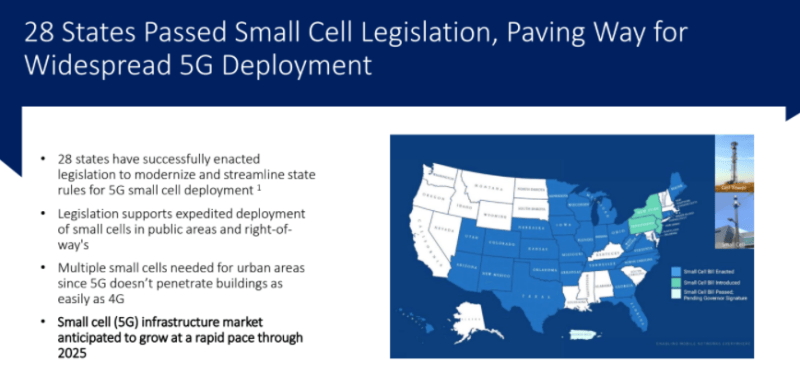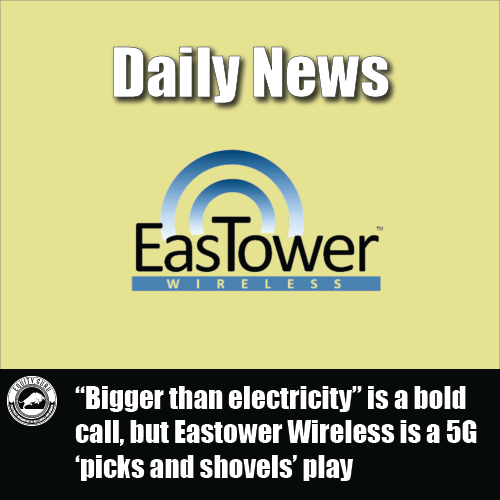If you’re unsure what 5G wireless is, and most are, even if they’ve heard its name spoken a few times, let’s start with the hyperbole and work backwards.
- “[5G will be] bigger than electricity” – Qualcomm
- “[5G is] one of the most important developments in human history.” – The Telegraph
- “[5G] will be as revolutionary as electricity or the automobile.” – World Economic Forum
Okay, settle down, Poindexter. For sure, 5G will be groundbreaking, but before we all bust out the hand cream, let’s understand why with a real world example.
On the weekend, while watching TV, one of my son’s friends knocked on the door. I picked up my phone and texted my son, who was in the next room, to get the door and a second later he was on his way down the stairs.
Let’s ignore how amazingly lazy I am on a weekend and explore how this happened.
I used my phone to connect to a wireless tower, which connected to the internet, which pinged a FIDO comms server and bounced to my kid’s coordinates, which came all the way back again, perhaps crossing half the country in the process, before it nestled into my kid’s phone 8 metres from where the chain started. It’s possible a satellite was involved, or that the signal worked its way across a border before coming back. We used billions of dollars in infrastructure so I could avoid going down stairs for a moment.
The internet, and the wireless communications that make up most of it these days, is in its 4th iteration, known as 4G. In a lot of the world, the system hasn’t yet shifted from the previous iteration – known as 3G.
3G was great because it allowed us the bandwidth to send pictures easily and inexpensively, ushering in the social media revolution. Before that, you’d have paid to send a text.
4G was far greater, because it brought the bandwidth to send one-way video easily and inexpensively, ushering in the streaming revolution.
But 5G? That’s not just the next step up in bandwidth. It’s a literal sea-change in bandwidth. It allows heavy bandwidth flowing in all directions, and from device to device, rather than routing everything through one chokepoint to the moon and back. With 5G, the internet isn’t on a server somewhere, it’s everywhere. Self-driving cars can assess dangers without having to send data back and forth through chokepoints. You could play video games on a cloud server with data running back and forth, rather than having to run them locally, which would bring in the age of ‘the Netflix of video games’. Virtual and augmented reality could be actual things that can work in real time, rather than in truncated, bloated form relying on 2D graphics to not overload systems.
You know why Fortnite looks like a cartoon? Because using low-fi graphics is the only way it can run decently on the current iteration of the internet.
But with 5G? No more.
SO 5G IS A GOOD THING – WHEN DO I GET MY VR HEADSET?
Well, let’s take about 10 or 20% off her there, big shoots. It’s going to take some time for Joe Game Developer to get their head around the possibilities of 5G, let alone for market demand to push the issue. These things usually start out benefiting the military and aerospace, government, then the media, then consumers over several years and this will be no different.
Before we rock on 5G, a wee government project called FirstNet has to be upgraded.
FirstNet is the US emergency services network, and the government has handed out a $100 billion contract to AT&T to get the entire first responder system upgraded to something called Band 14 – stat – or the money goes bye bye.
Good for AT&T, right?
Wrong. Because setting up Firstnet isn’t a case of just climbing a wireless tower and drilling an antenna on to it. This isn’t a process of upgrading tech so much as replacing tech, and the skillset needed to install it is in short supply, so AT&T is doling out that cash to any contractor that can help make a dent in the job.
Sadly, not many can.
 ENTER EASTOWER WIRELESS (ESTW.V).
ENTER EASTOWER WIRELESS (ESTW.V).
Eastower has been clanging up and down towers since 2015, with clients including all the major telcos, and a host of Government agencies. The current drive is in handling work in its home state of Florida, where multi-billion budgets are being allocated.
While there’s mild panic over getting FirstNet done before the government rage quits on its budget, there’s also the little issue of $65 billion the Biden administration has just laid out for high speed broadband upgrades across America as part of the Infrastructure Spending Plan.
Now, you may think this is all very luxurious, and that the telcos will drag their feet on 5G installation because, let’s face it, they usually aren’t in a big hurry to upgrade the internet and wireless backbones outside of the big cities.
Here’s the thing though; 5G is less expensive, more convenient, and more profitable at the consumer end than the old system. Basically, the telcos have EVERY INCENTIVE to get their 5G networks in place, ASAP.
The only barrier to that is the human barrier, and that’s where Eastower Wireless becomes an A-Grade ‘picks and shovels’ play for the 5G world.

Eastower’s services include:
- Network rollout project management
- New site builds
- Cellular/microwave builds or LTE (line and antenna work) collocation construction
- Tiger Team support (>500 sites served to-date)
- Site maintenance, audits, and decommissioning
- Fiber optic underground installation at cell sites
- Secure warehouse services
Not all 5G installs are on wireless towers. Some will be under manhole covers, or on light poles. Some will be inside buildings, or on their roofs, or in appliances. Factories will be outfitted with small cells to handle their own load. Let’s be clear, this is a WHOLESALE REBUILDING OF THE INTERNET TO A SCALE NOT ANTICIPATED A DECADE AGO.
If Eastower had 10,000 employees capable of installing 5G today, they’d be booked out tomorrow and earning fat cash for the company. So the company, right now, is on a hiring and training blitz so they can serve the tower companies, telcos, OEMs, government agencies, and military needs of the USA.
THE NUMBERS:
Eastower generates $70k per 4-person crew, per month. It costs them $75k to get a crew trained, certified, and running, and they have an average gross margin of between 37% and 52%, so it doesn’t take long to repay their investment. At the current rate of growth, ESTW will be break even by Q4 of this year, according to estimates, but the company is also determined not to fall into a ‘get rich quick’ mentality of cutting corners chasing short term deals at the expense of long term reputation. Their crews are not released into the world until they’re best-in-class, and they go the extra step to ensure that they’ll remain at the front of every job queue. To me, that’s important, because you don’t want to be a company that’s a necessity, you want to also be an aspiration.
“If you can, Bob, get Eastower for the job.”
Some may not like that strategy, reasoning that when there’s a shortage of contractors out there in the world, you can get away with cutting costs, but when you’re dealing in government contracts that could repeat for the next 25 years, be the gold standard.
In addition, Covid has blown through a lot of Eastower’s competitors, with some crews retiring early, some finding other work, and some parent companies not having the means to keep going through lockdowns. Their crash has been Eastower’s gain, with a long roster of potential takeover targets from the Carolinas to Florida, Louisiana through Texas, Oklahoma, Tennessee, and Kentucky.
While they train their own crews, taking out competitors, absorbing their crews, and upgrading their services makes all the sense in the world. In fact, Eastower has a target list of some 1,170 crews across the United States.
While all that’s happening, there’s still a lot of the United States that requires maintenance and lower-level upgrades to existing wireless and fibreoptic networks, so wherever the sweetest, most profitable jobs are, Eastower can slide right in.
5G mega players in the infrastructure space already do massive revenue. MasTec (MTZ.NYSE), as an example, does $8B in revenue in New York and Florida. Crown Castle (CCI.NYSE) is a tower owner/operator and did $5.8B last year.
Eastower didn’t do those numbers, but that’s why the market cap at the debut of its public markets listing today will start around $15M and not $15B.
If you’re looking for small sized picks and shovels in a monster market that they’re hugely well positioned in, where there’s still a ton of value to be had on the stock side, dive in today.
Get exposed to the guys putting up the wires for the ‘new electricity’.
— Chris Parry
FULL DISCLOSURE: The author has been a buyer of Eastower in private financings over the last few years and holds a strong position. He first wrote it up nearly a year ago.





